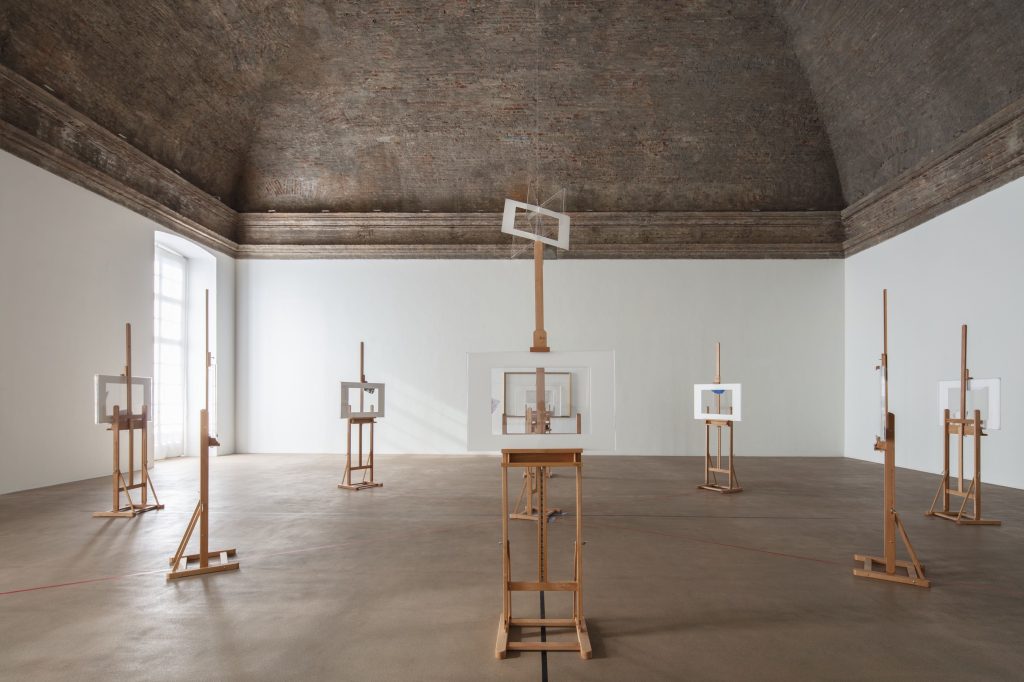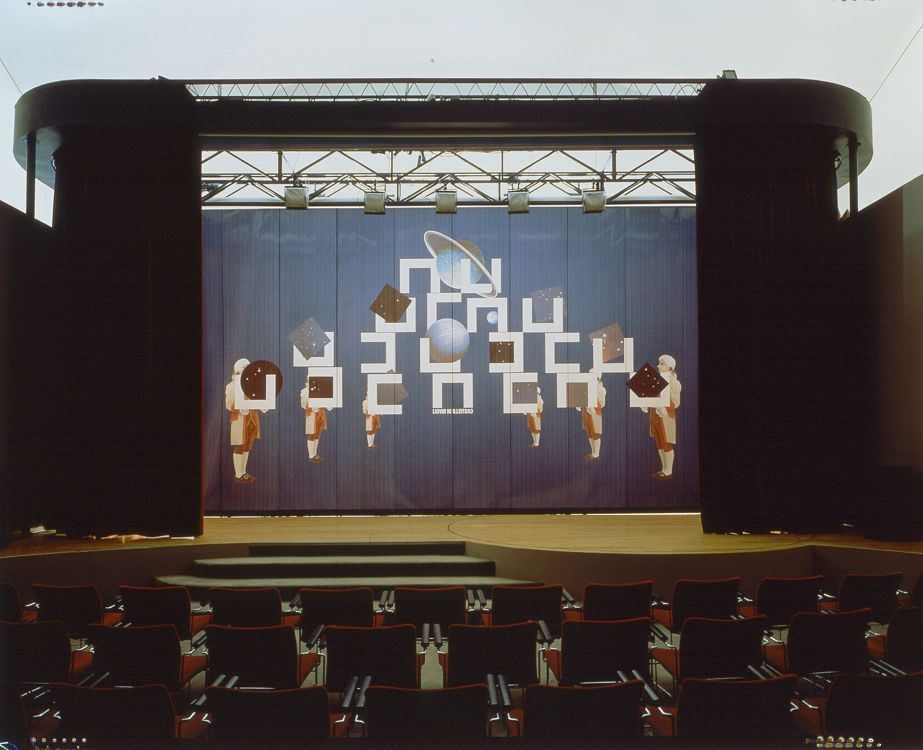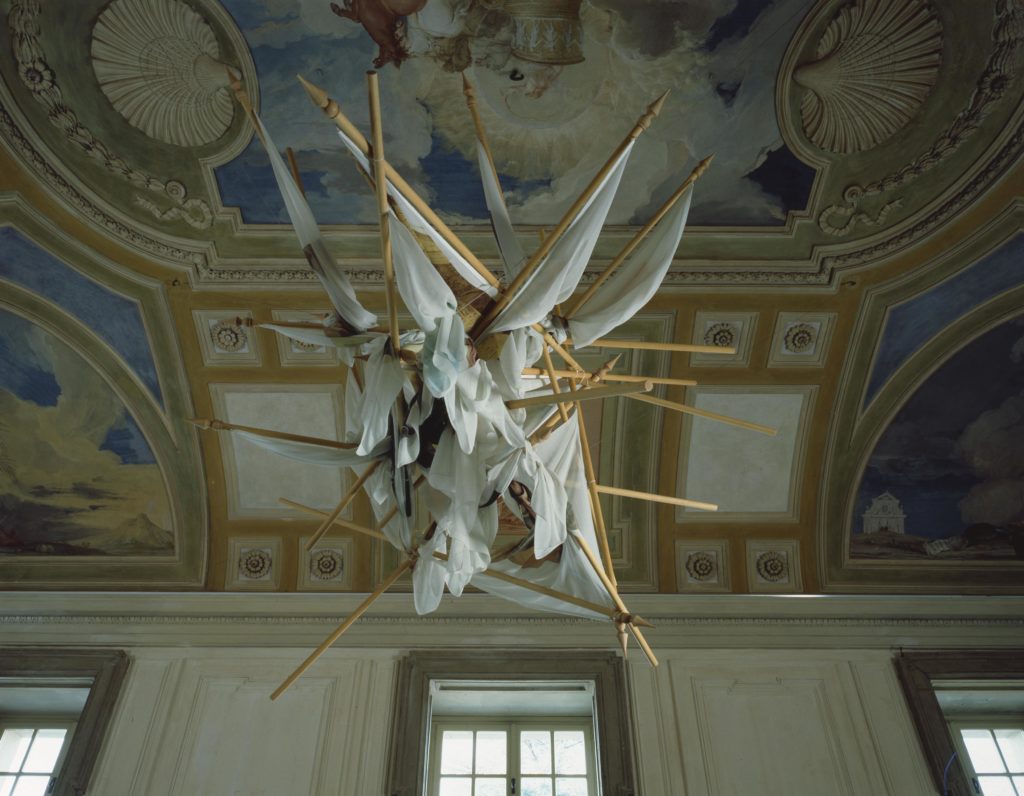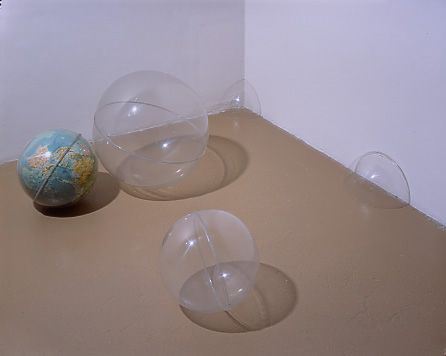Giulio Paolini
Giulio Paolini is interested in analyzing the intellectual process of artistic creation. The works in the collection of the Castello follow a chronological path through his primary thematic interests and his varied modes of visual expression.
Senza titolo (Untitled),1964,belongs to a series of works created at the beginning of Paolini ’s career that addresses the relationship between support and image. Two simple wooden panels of different dimensions are hung on the wall; the smaller is positioned at the center of the larger one in such a way that the proportions between the two allude to those that exist between a painting and the wall and
between the work and the exhibition space that contains it.
In liberating the painting from its function as a vehicle of depiction, the artist undertakes a voyage within the
conventions of exhibiting art, analyzing and deconstructing them from within.
1/25 ,1965,is a photograph that depicts the artist transporting a canvas, only the back of which is visible. The
title refers to the exposure time taken to shoot the frame and introduces the temporal element as a recurrent component of his work. Created by a professional photographer, Franco Aschieri, the image indicates the relationship that is established between the artist and his works, between his person and the image that is or will be represented.
Astrolabe (F.P.),1967,cites a drawing by Francis Picabia, who is referenced by the two initials contained between parentheses. The work is made up of five elements —four spheres or portions of spheres in Plexiglas and one globe, to be arranged freely in the space. The astrolabe, an ancient instrument used for measuring positions in the celestial sphere, provides clues for interpreting the meaning of art as
a repertory of collective memory. However the true subject resides in the convergence between creation and
perception. Paolini ’s visual language is full of infinite reflections, constituting a language that is self-generating, in search of the objective fundamentals of painting. This can be seen in Primo appunto sul tempo (First Note on Time), 1968,consisting of a white canvas covered with a sheet of paper on which there is no image but only some writing, at the upper left, from which the painting takes its title. These words make the moment absolute, and the time of the work consequently coincides with that of its creation so that
it lives in the moment of the viewer ’s gaze. Apoteosi di Omero (Apotheosis of Homer),1970 –71,pays homage to a painting by Ingres, now in the Louvre, in which various figures from past eras share space in the same scene. In this allegorical painting the figure of Homer, placed at the center of the composition, represents the model of perfection to which one should aspire —classicism as the symbol of formal beauty. Here the analytical and geometric investigation seen in Paolini ’s early works is followed by a passion for theatrical representation,an interest in the organization of the space of the stage and a predilection for
quotation. In Apoteosi di Omero ,a series of photographs that depict theater or film actors playing historical figures are positioned on lecterns, as if they were scores, arranged without a center, without one particular point of reference.
The scene, organized without any narrative, and with a lack of connection among the figures, indicates that the representation might never have an end and that the number of figures involved could be infinite. A tape plays the voices of two narrators who each recite one of the artist ’s writings, in two different languages.
The artist ’s tendency toward absolute identification with a classical model is apparent in Casa di Lucrezio (House of Lucretius),1981,a work created in seven versions. In the example in the Castello ’s collection,four fragments of a plaster slab featuring a carved drawing of a labyrinth, which were discovered in the house of Lucretius in Pompeii, are joined with four casts, two intact and two shattered —possible likenesses of the ancient poet —positioned on four bases. According to Paolini ’s ideas, it is in the fragments, traces of possible forms of elusive bodies, that we can glimpse the fullness of classical beauty and its formal and
intellectual perfection. The artist compares himself to the poet, in a self-reflective dialectic characterized by
fragmentation, the double, and mirror images as stylistic elements in the ideation of a stage-set architecture. Behind a geometrically ordered facade and beyond the rational clarity of the contents, his works reveal an intrinsic labyrinthine spirit, an empty space that goes beyond the physical limitations of the painting and disturbs the enigmatic quiet of his compositions.
With penetrating clarity the artist reflects on himself, on the history of art of the past and present, and on the visual imagination, as seen in Il cielo e dintorni (The Sky and Surroundings),1988,in which eighteen flags, each of which contains a specific element taken from a well-known masterpiece, are collected into a single entity. Originally conceived for an outdoor location, this installation was designed by the artist for an interior. Like signs of memory offered to the wind, the images of our culture represent, for the artist, a tool for embarking on a journey that imbues the place of vision with vitality.
In Paolini ’s poetic imagination all of his works can be interpreted as part of a unified set of intentions, “a painting that contains all paintings,” which proceeds and develops in passages, crossings, and quotations, as seen in Sipario e il Fondale per il Teatro del Castello di Rivoli (Curtain and Backdrop for the Theater at Castello di Rivoli),1997.The two large canvases, created specifically for the Museum ’s theater, metaphorically represent the interval that separates us from the image.The figures of six pageboys,“ancient ” inhabitants of the site, are laid out in perspective, like architectural elements that define the space of representation. Guardians of images, they bring on-stage
the Museum ’s graphic logo, an iconographic element that frames details of works in the Castello ’s collection against the white backdrop, and fragments of stars and planets against the midnight-blue backdrop.
In Zeusi e Parrasio (Zeuxis and Parrhasius),2003,history merges with legend, in a dialogue between truth and fiction that typifies Paolini ’s poetics. Although the title refers to two artists who were renowned in antiquity, we have neither descriptions nor actual works that might confirm their talent, but only the account of Pliny the Elder, according to whom they were involved in a competition to determine which of the two was the greatest painter. Through the memory of this anecdote, Paolini stages a fascinating mental operation. The fragments of two faces, contained in display cases and placed on two bases, are arranged on front of a white canvas on which there is a drawing of the surrounding space. The fragmentation of the casts reflects the break-up of visual and conceptual unity. The two figures, Zeuxis and Parrhasius, disappear into the void represented in the canvas that still awaits an image. It is the artist who vanishes before the work to come, in a play of roles and exchanges between artist and viewer. This work, like all Paolini ’s art, deals with the idea of the glance, in a study of correspondences and analogies that quote the past, opening up new perspectives and indicating new boundaries for artistic research. The works on paper in the Castello ’s collection represent the artist ’s private and personal response to his ongoing reflections and rely
aesthetically on quotation, duplication, and fragmentation, in a relationship between the solids and voids of images.
Il cielo e dintorni (The Sky and Surroundings),1988,is a sequence composed of eighteen preparatory drawings for the eponymous work; La pura verità (The Simple Truth), 1994,is a combinatorial play of signs and a visual anagram.
In Studio per ‘A perdita d ’occhio ’(Study for ‘As Far as the Eye Can See ’),2007,a boat, a metaphor for the artist ’s studio, glides over the water. It marks a recent return to collage for Paolini and poetically summarizes the path he has taken in his work —a continuous search for a landing in the journey within his artistic vision. Stanza 18 (Il momento della verità)(Room 18 – The Moment of Truth),2008, records a specific moment, a suspended instant in which Paolini verifies the results he has achieved and glimpses spaces yet to be confronted. Conceived for the exhibition of the Castello ’s collection, the work represents an image
developed within the eye socket, through which we perceive the opening of a timeless vision. We thus enter into an extremely private and personal zone; the viewer observes the artist while he observes himself in the act of witnessing the work ’s conception.
[G.C.]












